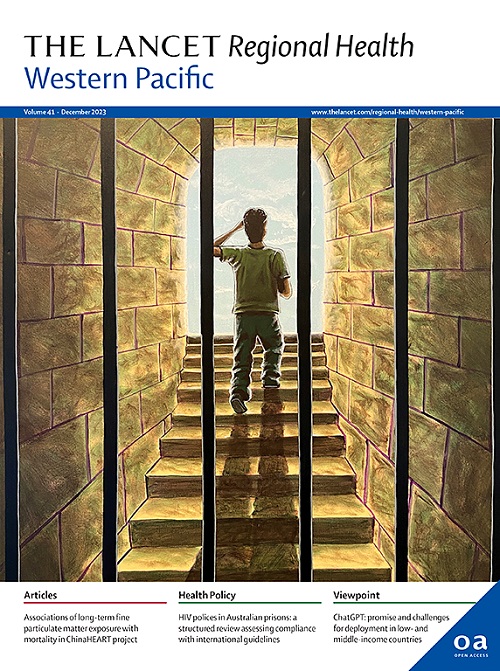Incretin-based drugs and the risk of gallbladder or biliary tract diseases among patients with type 2 diabetes across categories of body mass index: a nationwide cohort study
IF 7.6
1区 医学
Q1 HEALTH CARE SCIENCES & SERVICES
引用次数: 0
Abstract
Background
Despite emerging evidence of gallbladder or biliary tract diseases (GBD) risk regarding incretin-based drugs, population-specific safety profile considering obesity is lacking. We aimed to assess whether stratification by body mass index (BMI) modifies the measures of association between incretin-based drugs and the risk of GBD.
Methods
We conducted an active-comparator, new-user cohort study using a nationwide claims data (2013–2022) of Korea. We included type 2 diabetes (T2D) patients stratified by Asian BMI categories: Normal, 18.5 to <23 kg/m2; Overweight, 23 to <25 kg/m2; Obese, ≥25 kg/m2. The primary outcome was a composite of GBD, including cholelithiasis, cholecystitis, obstruction of the gallbladder or bile duct, cholangitis, and cholecystectomy. We used 1:1 propensity score (PS) matching and estimated hazard ratios (HR) with 95% confidence intervals (CI) using Cox models.
Findings
New users of DPP4i and SGLT2i were 1:1 PS matched (n = 251,420 pairs; 186,697 obese, 39,974 overweight, and 24,749 normal weight pairs). The overall HR for the risk of GBD with DPP4i vs. SGLT2i was 1.21 (95% CI 1.14–1.28), with no effect modification by BMI (p-value: 0.83). For the second cohort, new users of GLP1RA and SGLT2i were 1:1 PS matched (n = 45,443 pairs; 28,011 obese, 8948 overweight, and 8484 normal weight pairs). The overall HR for the risk of GBD with GLP1RA vs. SGLT2i was 1.27 (1.07–1.50), with no effect modification by BMI (p-value: 0.73).
Interpretation
The increased risks of GBD were presented in both cohorts with no evidence of effect heterogeneity by BMI.
Funding
Ministry of Food and Drug Safety, Health Fellowship Foundation.
基于肠促胰岛素的药物与不同体重指数的2型糖尿病患者胆囊或胆道疾病的风险:一项全国性队列研究
尽管基于肠促胰岛素的药物存在胆囊或胆道疾病(GBD)风险的新证据,但考虑到肥胖,缺乏针对人群的安全性分析。我们的目的是评估体重指数(BMI)分层是否会改变基于肠促胰岛素的药物与GBD风险之间的相关性。方法:采用韩国2013-2022年全国索赔数据,开展了一项活跃比较、新用户队列研究。我们纳入了按亚洲BMI分类的2型糖尿病(T2D)患者:正常,18.5至23 kg/m2;超重,23至25公斤/平方米;肥胖,≥25kg /m2。主要结局是GBD的复合结局,包括胆石症、胆囊炎、胆囊或胆管梗阻、胆管炎和胆囊切除术。我们使用了1:1的倾向评分(PS)匹配,并使用Cox模型估计了95%置信区间(CI)的风险比(HR)。发现DPP4i和SGLT2i的新用户为1:1 PS匹配(n = 251,420对;186,697对肥胖,39,974对超重,24,749对正常体重)。DPP4i与SGLT2i合并GBD风险的总HR为1.21 (95% CI 1.14-1.28), BMI没有影响(p值:0.83)。在第二个队列中,GLP1RA和SGLT2i的新用户为1:1 PS匹配(n = 45,443对;28,011对肥胖,8948对超重,8484对正常体重)。GLP1RA与SGLT2i合并GBD风险的总HR为1.27 (1.07-1.50),BMI没有影响(p值:0.73)。解释:两个队列中均出现GBD风险增加,没有证据表明BMI存在影响异质性。经费来源:国家食品药品安全与卫生研究院基金。
本文章由计算机程序翻译,如有差异,请以英文原文为准。
求助全文
约1分钟内获得全文
求助全文
来源期刊

The Lancet Regional Health: Western Pacific
Medicine-Pediatrics, Perinatology and Child Health
CiteScore
8.80
自引率
2.80%
发文量
305
审稿时长
11 weeks
期刊介绍:
The Lancet Regional Health – Western Pacific, a gold open access journal, is an integral part of The Lancet's global initiative advocating for healthcare quality and access worldwide. It aims to advance clinical practice and health policy in the Western Pacific region, contributing to enhanced health outcomes. The journal publishes high-quality original research shedding light on clinical practice and health policy in the region. It also includes reviews, commentaries, and opinion pieces covering diverse regional health topics, such as infectious diseases, non-communicable diseases, child and adolescent health, maternal and reproductive health, aging health, mental health, the health workforce and systems, and health policy.
 求助内容:
求助内容: 应助结果提醒方式:
应助结果提醒方式:


